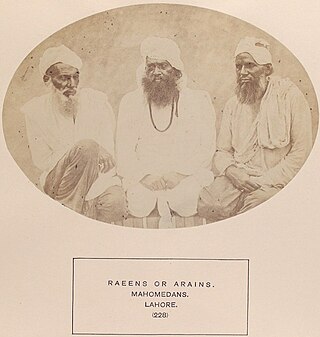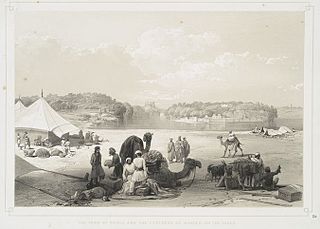Related Research Articles

Punjab, also known as the Land of the Five Rivers, is a geopolitical, cultural, and historical region in South Asia. It is specifically located in the northwestern part of the Indian subcontinent, comprising areas of modern-day eastern-Pakistan and northwestern-India. Punjab's major cities are Lahore, Faisalabad, Rawalpindi, Gujranwala, Multan, Ludhiana, Amritsar, Sialkot, Chandigarh, Shimla, Jalandhar, Patiala, Gurugram, and Bahawalpur.

Gujrat is a city in the Pakistani province of Punjab. It is the headquarters of the Gujrat District and the 20th largest city in Pakistan, with a population of over 390,000 in 2017. Along with the nearby cities of Sialkot and Gujranwala, Gujrat forms part of the Golden Triangle of industrial cities with export-oriented economies.

A zamindar in the Indian subcontinent was an autonomous or semi-autonomous feudal ruler of a zamindari. The term itself came into use during the reign of Mughals, Marathas and later the British had begun using it as a native synonym for "estate". The term means landowner in Persian. They were typically hereditary, and held the right to collect tax on behalf of imperial courts or for military purposes.

Khatri is a caste originating from the Malwa and Majha areas of Punjab in South Asia, predominantly on the Indian Subcontinent. The Khatris claim they were warriors who took to trading. Within the Indian Subcontinent, they were mostly engaged in mercantile professions, such as banking and trading. They were the dominant commerce caste of financiers in late-medieval India. Some families and individuals in Punjab belonged to hereditary agriculturalist land-holding lineages, while others were engaged in artisanal occupations, such as silk production (sericulture) and weaving.

Kasur is a city to the south of Lahore, in the Pakistani province of Punjab. The city serves as the headquarters of Kasur District. Kasur is the 16th largest city in Punjab and 24th largest in Pakistan, by population. It is also known for being the burial place of the 17th-century Sufi-poet Bulleh Shah. It is farther west of the border with neighboring India, and bordered to Lahore, Sheikhupura and Okara Districts of Punjab. The city is an aggregation of 26 fortified hamlets overlooking the alluvial valleys of the Beas and Sutlej rivers.

Arain are a large Punjabi Muslim agricultural community with a strong political identity and level of organisation.
Khokhar is a historical Punjabi tribe primarily native to the Pothohar Plateau of Pakistani Punjab. Khokhars are also found in the Indian states of Punjab and Haryana. Khokhars predominantly follow Islam, having converted to Islam from Hinduism after coming under the influence of Baba Farid.

Arora is a Punjabi caste, comprising both Hindus and Sikhs. The name is derived from their native place Aror. In 712, the Arora people are said to have left Aror and started to settle in the cities of Punjab, mainly in South Punjab. However, according to W. H. McLeod, many Aroras originally came from Pothohar area.
Muslim Rajputs or Musalman Rajpoots are the descendants of Rajputs in the northern regions of the Indian subcontinent who generally are followers of Islam. Reportedly, they converted from Hinduism to Islam from the medieval period onwards, creating various dynasties and states while retaining Hindu surnames such as Chauhan. Today, Muslim Rajputs can be found mostly in present-day Northern India and Pakistan. They are further divided into different clans.
The Sial or Siyal is a Punjabi clan found in the Punjab region of the Indian subcontinent, split between India and Pakistan.

Moga district is one of the twenty-two districts in the state of Punjab, India. It became the 17th district of Punjab State on 24 November 1995 cut from Faridkot district. Moga District is among the largest producers of wheat and rice in Punjab, India. People from Moga City and Moga District belong to the Malwa culture. The district is noted for being the homeland for a high proportion of Indian Punjabi expatriates who emigrated abroad and their descendents, which has given it the nickname of "NRI district".
Moga is a city in the Indian state of Punjab. It was made a part and headquarters of the Moga district on 24 November 1995, by the then Chief Minister Harcharan Singh Brar. Before becoming a district, Moga was a part of Faridkot District as a tehsil. Moga is situated on the National Highway 95. The area of Dharamkot block with 150 villages has been merged into Moga district, which falls under the jurisdiction of Ferozpur division.
Malwa is a geographical region in the south of Punjab state in India. It is located between south of the Sutlej river, north of the Ghaggar river, east of Pakistan, and west of the Sivalik Hills.
Jat Sikh or Jatt Sikh is an ethnoreligious group and a subgroup of the Jat people and the Sikh people from the Indian subcontinent. They are one of the dominant communities in the Punjab, India owing to their large land holdings. They form an estimated 20–25% of the population of the Indian state of Punjab. They form at least half of the Sikh population in Punjab, with some sources estimating them to be about 60–66% appx. two-third of the Sikh population.
The Gurjar are an Indo-Aryan agricultural ethnic community, residing mainly in India, Pakistan and Afghanistan, divided internally into various clan groups. They were traditionally involved in agriculture, pastoral and nomadic activities and formed a large heterogeneous group. The historical role of Gurjars has been quite diverse in society: at one end they have been founders of several kingdoms and dynasties and, at the other end, some are still nomads with no land of their own.
Jat Muslim or Musalman Jat, also spelled Jatt or Jutt, are an elastic and diverse ethno-social subgroup of the Jat people, who are composed of followers of Islam and are native to the northern regions of the Indian subcontinent. They are found primarily throughout the Sindh and Punjab regions of Pakistan. Jats began converting to Islam from the early Middle Ages onward and constitute a distinct subgroup within the diverse community of Jat people.
Punjabi Muslims are adherents of Islam who identify ethnically, linguistically, culturally, and genealogically as Punjabis. With a population of more than 109 million, they are the largest ethnic group in Pakistan and the world's third-largest Islam-adhering ethnicity after Arabs and Bengalis. The majority of Punjabi Muslims are adherents of Sunni Islam, while a minority adhere to Shia Islam. They are primarily geographically native to the Punjab province of Pakistan, but many have ancestry from the Punjab region as a whole.
The Jat people are a traditionally agricultural community in Northern India and Pakistan. Originally pastoralists in the lower Indus river-valley of Sindh, many Jats migrated north into the Punjab region in late medieval times, and subsequently into the Delhi Territory, northeastern Rajputana, and the western Gangetic Plain in the 17th and 18th centuries. Of Hindu, Muslim and Sikh faiths, they are now found mostly in the Indian states of Punjab, Haryana, Uttar Pradesh and Rajasthan and the Pakistani provinces of Sindh and Punjab.
Dadwal, also written as Dadhwal and Dhadwal, is a surname prevalent in Punjab, Himachal Pradesh and Jammu. The surname is prevalent in the Rajput community. It is also prevalent in the Jatt community and is a clan name amongst Hindus and Sikhs.
References
- 1 2 John, A (2009). Two dialects one region: a sociolinguistic approach to dialects as identity markers (PDF) (MA thesis). Ball State University. Archived from the original on 5 November 2022.
- 1 2 3 Singh, C (1988). "Conformity and conflict: tribes and the 'agrarian system' of Mughal India" (PDF). The Indian Economic & Social History Review. 25 (3): 319–340. doi:10.1177/001946468802500302.[ permanent dead link ]
- ↑ Fiaz, HM; Akhtar, S; Rind, AA (2021). "Socio-cultural condition of South Punjab: a case of Muzaffargarh District". International Research Journal of Education and Innovation. 2 (2): 21–40. doi: 10.53575/irjei.3-v2.2(21)21-40 .
- 1 2 Chaudhuri, BB (2008). Peasant History of Late Pre-colonial and Colonial India. Vol. 8. Pearson Education India. pp. 194–195. ISBN 978-8-13171-688-5.
- ↑ Singh C (1988). "Centre and periphery in the Mughal State: the case of seventeenth-century Panjab". Modern Asian Studies. 22 (2). 313. doi:10.1017/s0026749x00000986. JSTOR 312624. S2CID 144152388.
- ↑ Gaeffke, P (1991). "Hīr Vāriṡ Śāh, poème panjabi du XVIIIe siècle: Introduction, translittération, traduction et commentaire. Tome I, strophes 1 à 110 by Denis Matringe [review]". Journal of the American Oriental Society. 111 (2): 408–409. doi:10.2307/604050. JSTOR 604050.
...and we come across scathing remarks about 'plebeians' such as Jats, Dogars and other agricultural castes.